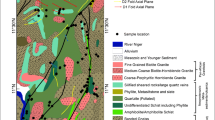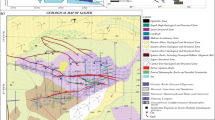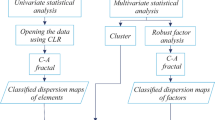Abstract
Various genesis of epithermal veins as well as host rock cause complication in the modeling process. Thus LINEST and controlling function were applied to improve the accuracy and the quality of the model. The LINEST is a model which is based on multiple linear regression and refers to a branch of applied statistics. This method concerns directly to the application of t-test (TINV and TDIST to analyses of variables in the model) and F-test (FDIST, F-statistic to compare different models) analysis. Backward elimination technique is applied to reduce the number of variables in the model through all the borehole data. After 18 steps, an optimized reduced model (ORM) was constructed and ranked in order of importance as Pb>Ag>P>Hg>Mn>Nb>U>Sr>Sn>As>Cu, with the lowest confidence level (CL) of 92% for Cu. According to the epigenetic vein genesis of Glojeh polymetallic deposit, determination of spatial patterns and elemental associations accompanied by anomaly separation were conducted by K-means cluster and robust factor analysis method based on centered log-ratio (clr) transformed data. Therefore, 12 samples (cluster 2) with the maximum distance from centroid, indicates the intensity of vein polymetallic mineralization in the deposit. In addition, an ORM for vein population was extracted for Sb>Al>As>Mg>Pb>Cu>Ag elements with the R2 up to 0.99. On the other hand, after 23 steps of optimization process at the host rock population, an ORM was conducted by Ag>Te>Hg>Pb>Mg>Al>Sb>As represented in descending order of t-values. It revealed that Te and Hg can be considered as pathfinder elements for Au at the host rock. Based on the ORMs at each population Ag, Pb, and As were often associated with Au mineralization. The concentration ratio of (tSb × tAl)vein/(tSb × tAl)background as an enrichment index can intensify the mineralization detection. Finally, Glojeh deposit was evaluated to be classified as a vein-style Au (Ag, Pb, As)-polymetallic mineralization.
Similar content being viewed by others
References
Abdi H, Williams L J, Valentin D (2013). Multiple factor analysis: principal component analysis for multi-table and multi-block data sets. Comput Stat, 5(2): 149–179
Almasi A, Jafarirad A, Kheyrollahi H, Rahimi M, Afzal P (2014). Evaluation of structural and geological factors in orogenic gold type mineralisation in the Kervian area, north-west Iran, using airborne geophysical data. Explor Geophys, 45(4): 261–270
Angelo R T, Cringan M S, Chamberlain D L, Stahl A J, Haslouer S G, Goodrich C A (2007). Residual effects of lead and zinc mining on freshwater mussels in the Spring River Basin (Kansas, Missouri, and Oklahoma, USA). Sci Total Environ, 384(1–3): 467–496
Bierlein F P, McKnight S (2005). Possible intrusion-related gold systems in the western Lachlan Orogen, southeast Australia. Econ Geol, 100: 385–398
Bise C J (2013). Modern American Coal Mining: Methods and Applications. Society for Mining, Metallurgy and Exploration
Blythe J N, Lea D W (2008). Functions of height and width dimensions in the intertidal mussel, Mytilus californianus. J Shellfish Res, 27(2): 385–392
Borah P, Singh M K, Mahapatra S (2015). Estimation of degree-days for different climatic zones of North-East India. Sustainable Cities and Society, 14: 70–81
Breidenbach J, McRoberts R E, Astrup R (2016). Empirical coverage of model-based variance estimators for remote sensing assisted estimation of stand-level timber volume. Remote Sens Environ, 173: 274–281
Briand G, Hill R C (2013). Teaching basic econometric concepts using Monte Carlo simulations in Excel. Int Rev Econ Educ, 12: 60–79
Buccianti A, Grunsky E (2014). Compositional data analysis in geochemistry: are we sure to see what really occurs during natural processes? Elsevier
Cheng Q (2007). Mapping singularities with stream sediment geochemical data for prediction of undiscovered mineral deposits in Gejiu, Yunnan Province, China. Ore Geol Rev, 32(1–2): 314–324
Ciobanu C L, Cook N J, Spry P G (2006). Telluride and selenide minerals in gold deposits—How and why? Mineral Petrol, 87(3–4): 163–169
Cook N J, Ciobanu C L (2005). Tellurides in Au deposits: implications for modelling. In: Mao J W, Bierlein F P, eds. Mineral Deposit Research: Meeting the Global Challenge. Proceedings of the 8th Biennial SGA Meeting, Beijing, China, 1387–1390
Cordell H J, Clayton D G (2002). A unified stepwise regression procedure for evaluating the relative effects of polymorphisms within a gene using case/control or family data: application to HLA in type 1 diabetes. Am J Hum Genet, 70(1): 124–141
Darabi-Golestan F, Ghavami-Riabi R, Asadi-Harooni H (2013). Alteration, zoning model, and mineralogical structure considering lithogeochemical investigation in Northern Dalli Cu–Au porphyry. Arab J Geosci, 6(12): 4821–4831
Darabi-Golestan F, Hezarkhani A (2016). High precision analysis modeling by backward elimination with attitude on interaction effects on Au (Ag)-polymetallic mineralization of Glojeh, Iran. J Afr Earth Sci, 124: 505–516
Darabi-Golestan F, Hezarkhani A (2017a). Evaluation of elemental mineralization rank using fractal and multivariate techniques and improving the performance by log-ratio transformation. J Geochem Explor, doi: 10.1016/j.gexplo.2017.09.011
Darabi-Golestan F, Hezarkhani A (2017b). R- and Q-mode multivariate analysis to sense spatial mineralization rather than uni-elemental fractal modeling in polymetallic vein deposits. Geosystem Engineering, doi: 10.1080/12269328.2017.1407266
Darabi-Golestan F, Hezarkhani A, Zare M (2017). Assessment of 226Ra, 238U, 232Th, 137Cs and 40K activities from the northern coastline of Oman Sea (water and sediments). Mar Pollut Bull, 118(1–2): 197–205
Darabi-Golestan F, Hezarkhani A, Zare M (2014). Interpretation of the sources of radioactive elements and relationship between them by using multivariate analyses in Anzali Wetland Area. Geoinformatics & Geostatistics. An Overview, 1: 4
DeCoursey W (2003). Statistics and Probability for Engineering Applications. New York: Elsevier
Dehak N, Kenny P J, Dehak R, Dumouchel P, Ouellet P (2011). Frontend factor analysis for speaker verification. IEEE Trans Audio Speech Lang Process, 19(4): 788–798
Dora M, Randive K (2015). Chloritisation along the Thanewasna shear zone,Western Bastar Craton, Central India: its genetic linkage to Cu–Au mineralisation. Ore Geol Rev, 70: 151–172
Egozcue J J, Pawlowsky-Glahn V, Mateu-Figueras G, Barcelo-Vidal C (2003). Isometric logratio transformations for compositional data analysis. Math Geol, 35(3): 279–300
Fávaro D, Damatto S, Moreira E, Mazzilli B, Campagnoli F (2007). Chemical characterization and recent sedimentation rates in sediment cores from Rio Grande reservoir, SP, Brazil. J Radioanal Nucl Chem, 273(2): 451–463
Filzmoser P, Hron K (2008). Outlier detection for compositional data using robust methods. Math Geosci, 40(3): 233–248
Filzmoser P, Hron K, Reimann C (2009). Principal component analysis for compositional data with outliers. Environmetrics, 20(6): 621–632
Fox R J (1983). Confirmatory Factor Analysis. Wiley Online Library
Garson G (2012). Multiple regression (statistical associates blue book series). Asheboro, NC: Statistical Associates Publishers
Grancea L, Bailly L, Leroy J, Banks D, Marcoux E, Milési J, Cuney M, André A, Istvan D, Fabre C (2002). Fluid evolution in the Baia Mare epithermal gold/polymetallic district, Inner Carpathians, Romania. Miner Depos, 37(6–7): 630–647
Guha S, Mishra N (2016). Clustering data streams. In: Garofalakis M, Gehrke J, Rastogi R. Data Stream Management: Processing High- Speed Data Streams. Springer Berlin Heidelberg, 169–187
Hamilton A, Campbell K, Rowland J, Browne P (2017). The Kohuamuri siliceous sinter as a vector for epithermal mineralisation, Coromandel Volcanic Zone, New Zealand. Miner Depos, 52(2): 181–196
Hargreaves B R, McWilliams T P (2010). Polynomial trendline function flaws in Microsoft Excel. Comput Stat Data Anal, 54(4): 1190–1196
Hezarkhani A (2008). Hydrothermal evolution of the Miduk porphyry copper system, Kerman, Iran: a fluid inclusion investigation. Int Geol Rev, 50(7): 665–684
Hill T, Lewicki P (2006). Statistics: methods and applications: a comprehensive reference for science, industry, and data mining. Tulsa: StatSoft, Inc.
Huang Z (1998). Extensions to the k-means algorithm for clustering large data sets with categorical values. Data Min Knowl Discov, 2(3): 283–304
Jiang S, Liu M, Hao J, Qian W (2015). A bi-layer optimization approach for a hybrid flow shop scheduling problem involving controllable processing times in the steelmaking industry. Comput Ind Eng, 87: 518–531
Jovic S M, Guido D M, Ruiz R, Páez G N, Schalamuk I B (2011). Indium distribution and correlations in polymetallic veins from Pingüino deposit, Deseado Massif, Patagonia, Argentina. Geochem Explor Environ Anal, 11(2): 107–115
Karamanis D, Ioannides K, Stamoulis K (2009). Environmental assessment of natural radionuclides and heavy metals in waters discharged from a lignite-fired power plant. Fuel, 88(10): 2046–2052
Kutner M H, Nachtsheim C J, Neter J, Li W (2005). Applied Linear Statistical Models. New York: McGraw-Hill Irwin
Larose D T (2006). Data Mining Methods & Models. New York: John Wiley & Sons: 1–223
Larose D T (2003). Discovering Knowledge in Data: An Introduction to Data Mining. Hoboken: John Wiley & Sous., 1–223
Liu Y, Cheng Q, Zhou K, Xia Q, Wang X (2016). Multivariate analysis for geochemical process identification using stream sediment geochemical data: a perspective from compositional data. Geochem J, 50(4): 293–314
MacQueen J (1967). Some methods for classification and analysis of multivariate observations. Proceedings of the fifth Berkeley symposium on mathematical statistics and probability, Oakland, CA, USA, 281–297
Martínez-Abad I, Cepedal A, Arias D, Fuertes-Fuente M (2015). The Au–As (Ag–Pb–Zn–Cu–Sb) vein-disseminated deposit of Arcos (Lugo, NW Spain): mineral paragenesis, hydrothermal alteration and implications in invisible gold deposition. J Geochem Explor, 151: 1–16
Mehrabi B, Siani M G, Azizi H (2014). The genesis of the epithermal gold mineralization at North Glojeh veins. NWIran. IJSAR, 15: 479–497
Mehrabi B, Siani M G, Goldfarb R, Azizi H, Ganerod M, Marsh E E (2016). Mineral assemblages, fluid evolution, and genesis of polymetallic epithermal veins, Glojeh district. NW Iran. Ore Geol Rev, 78: 41–57
Mihai D, Mocanu M (2015). Statistical considerations on the k-means algorithm. Annals of the University of Craiova-Mathematics and Computer Science Series, 42: 365–373
Mohammadi N M, Hezarkhani A, Maghsoudi A (2018). Application of K-means and PCA approaches to estimation of gold grade in Khooni district (central Iran). Acta Geochimica, 37(1): 102–112
Myers R H, Montgomery D C, Anderson-Cook C M (2016). Response Surface Methodology: Process and Product Optimization Using Designed Experiments. John Wiley & Sons
Namhata A, Zhang L, Dilmore R M, Oladyshkin S, Nakles D V (2017). Modeling changes in pressure due to migration of fluids into the above zone monitoring interval of a geologic carbon storage site. Int J Greenh Gas Control, 56: 30–42
Naumov V, Osovetsky B (2013). Mercuriferous gold and amalgams in Mesozoic-Cenozoic rocks of the Vyatka-Kama Depression. Lithol Miner Resour, 48(3): 237–253
Nude P M, Asigri J M, Yidana S M, Arhin E, Foli G, Kutu J M (2012). Identifying pathfinder elements for gold in multi-element soil geochemical data from the Wa-Lawra belt, northwest Ghana: a multivariate statistical approach. Int J Geosci, 3(01): 62–70
Oyman T, Minareci F, Pişkin Ö (2003). Efemcukuru B-rich epithermal gold deposit (Izmir, Turkey). Ore Geol Rev, 23(1–2): 35–53
Parnell J, Spinks S, Bellis D (2016). Low-temperature concentration of tellurium and gold in continental red bed successions. Terra Nova, 28 (3): 221–227
Pawlowsky-Glahn V, Egozcue J (2006). Compositional data and their analysis: an introduction. Geol Soc Lond Spec Publ, 264(1): 1–10
Radosavljević S A, Stojanović J N, Vuković N S, Radosavljević- Mihajlović A S, Kašić V D (2015). Low-temperature Ni-As-Sb-S mineralization of the Pb (Ag)-Zn deposits within the Rogozna ore field, Serbo-Macedonian Metallogenic Province: ore mineralogy, crystal chemistry and paragenetic relationships. Ore Geol Rev, 65: 213–227
Ramasamy V, Sundarrajan M, Paramasivam K, Meenakshisundaram V, Suresh G (2013). Assessment of spatial distribution and radiological hazardous nature of radionuclides in high background radiation area, Kerala, India. Appl Radiat Isot, 73: 21–31
Reith F, McPhail D, Christy A (2005). Bacillus cereus, gold and associated elements in soil and other regolith samples from Tomakin Park Gold Mine in southeastern New South Wales, Australia. J Geochem Explor, 85(2): 81–98
Remenyi D, Onofrei G, English J (2011). An introduction to statistics using Microsoft Excel. Academic Conferences and Publishing International Ltd.
Røislien J, Omre H (2006). T-distributed random fields: a parametric model for heavy-tailed well-log data. Math Geol, 38(7): 821–849
Samal A R, Mohanty M K, Fifarek R H (2008). Backward elimination procedure for a predictive model of gold concentration. J Geochem Explor, 97(2–3): 69–82
Savazzi E, Reyment R (1999). Aspects of Multivariate Statistical Analysis in Geology. Elsevier
Soheily-Khah S, Douzal-Chouakria A, Gaussier E (2016). Generalized k-means-based clustering for temporal data under weighted and kernel time warp. Pattern Recognit Lett, 75: 63–69
Stanciu C (1973). Hydrothermal alteration of Neogene volcanics rocks from ore deposits in Gutai Mountains (East Carpathians). Rev Roum Geol Geophys Geogr Ser Geol, 17: 43–62
Suresh G, Sutharsan P, Ramasamy V, Venkatachalapathy R (2012). Assessment of spatial distribution and potential ecological risk of the heavy metals in relation to granulometric contents of Veeranam lake sediments, India. Ecotoxicol Environ Saf, 84: 117–124
Székely G J, Rizzo M L (2013). The distance correlation t-test of independence in high dimension. J Multivariate Anal, 117: 193–213
Templ M, Filzmoser P, Reimann C (2008). Cluster analysis applied to regional geochemical data: problems and possibilities. Appl Geochem, 23(8): 2198–2213
Tokatli C, Köse E, Çiçek A (2014). Assessment of the effects of large borate deposits on surface water quality by multi statistical approaches: a case study of Seydisuyu Stream (Turkey). Pol J Environ Stud, 23: 1741–1751
Vriend S, Van Gaans P, Middelburg J, De Nijs A (1988). The application of fuzzy c-means cluster analysis and non-linear mapping to geochemical datasets: examples from Portugal. Appl Geochem, 3 (2): 213–224
Wang W, Zhao J, Cheng Q (2014). Mapping of Fe mineralizationassociated geochemical signatures using logratio transformed stream sediment geochemical data in eastern Tianshan, China. J Geochem Explor, 141: 6–14
Yalta A T (2008). The accuracy of statistical distributions in Microsoft® Excel 2007. Comput Stat Data Anal, 52(10): 4579–4586
Yang L, Wang Q, Liu X (2015). Correlation between mineralization intensity and fluid–rock reaction in the Xinli gold deposit, Jiaodong Peninsula, China: constraints from petrographic and statistical approaches. Ore Geol Rev, 71: 29–39
Yousefi M, Kamkar-Rouhani A, Carranza E J M (2014). Application of staged factor analysis and logistic function to create a fuzzy stream sediment geochemical evidence layer for mineral prospectivity mapping. Geochem Explor Environ Anal, 14(1): 45–58
Zaiontz C (2014). Real statistics using Excel. http://www.real-statistics. com/regression/power-regression/
Zarandi MF, Yazdi E H (2008). A type-2 fuzzy rule-based expert system model for portfolio selection. Proceeding of The 11th Joint Conference On Information Sciences. Atlantis Press
Zhang D, Cheng Q, Agterberg F, Chen Z (2016). An improved solution of local window parameters setting for local singularity analysis based on Excel VBA batch processing technology. Comput Geosci, 88: 54–66
Zhao X, Xue C, Symons D T, Zhang Z, Wang H (2014). Microgranular enclaves in island-arc andesites: a possible link between known epithermal Au and potential porphyry Cu–Au deposits in the Tulasu ore cluster, western Tianshan, Xinjiang, China. J Asian Earth Sci, 85: 210–223
Zhu Y, An F, Tan J (2011). Geochemistry of hydrothermal gold deposits: a review. Geoscience Frontiers, 2(3): 367–374
Ziaii M, Carranza E J M, Ziaei M (2011). Application of geochemical zonality coefficients in mineral prospectivity mapping. Comput Geosci, 37(12): 1935–1945
Acknowledgements
The authors are grateful to the Iranian Mines and Mining Industries Development & Renovation Organization (IMIDRO) for their permission to have access to Glojeh deposit dataset.
Author information
Authors and Affiliations
Corresponding author
Rights and permissions
About this article
Cite this article
Darabi-Golestan, F., Hezarkhani, A. Applied statistical functions and multivariate analysis of geochemical compositional data to evaluate mineralization in Glojeh polymetallic deposit, NW Iran. Front. Earth Sci. 13, 229–246 (2019). https://doi.org/10.1007/s11707-018-0705-0
Received:
Accepted:
Published:
Issue Date:
DOI: https://doi.org/10.1007/s11707-018-0705-0




